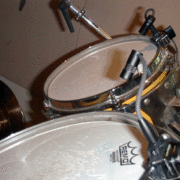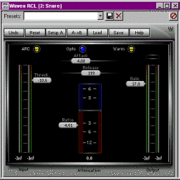PLEASE NOTE: This article has been archived. It first appeared on ProRec.com in March 2000, contributed by then Editor-in-Chief Rip Rowan. We will not be making any updates to the article. Please visit the home page for our latest content. Thank you!
The announcement of MOTU’s 24i audio interface in the fall of last year gave me mixed feelings. The 24i, which sports 24 balanced +4 inputs and 2 balanced +4 outputs, is clearly the audio interface solution that the computer-based recording community has been asking for. This is an interface targeted at the person who is doing all of their mixing inside the computer, and who wants maximum inputs, but only needs stereo outputs.
We Are Family
MOTU’s interface family, which won the ProRec Reader’s Choice Award for Best New Audio Interface Technology, is an impressive lineup. If you don’t understand how the family operates together, then you’ll really miss the point of MOTU’s interface products.
The core of MOTU’s system is the PCI-324 card. This is the part that goes into your computer. It fits into a standard PCI slot in either a Mac or PC. Up to three MOTU interfaces at a time can plug into the 324. The interfaces are sold as “expansion” or “core” systems. The “core systems” include the 324 PCI card. The “expansion systems” are sold without the 324 card as add-ons to existing systems.
So again, to clarify (because I get a lot of questions about this) any three interfaces can be plugged into the system at the same time, and up to 24 inputs and outputs on each interface can be live simultaneously for a whopping 72 active inputs and outputs.
Match and Mix
Here are the interface options:
2408: 8 channels of 20-bit analog I/O on unbalanced -10 RCA connectors, 24 channels of ADAT I/O on three lightpipe connectors, 24 channels of TASCAM I/O on three TDIF connectors, a pair of S/PDIF I/Os, and word clock sync. Up to 24 channels can be active at one time, for example, 8 analog I/Os and 16 ADAT I/Os. (A new model with 24-bit A/D converters was recently announced.)
1224: 8 channels of 24-bit analog I/O on +4 balanced ¼” TRS connectors, plus 2 channels of +4 balanced “Main Outs” on XLR connectors and a headphone jack, plus a pair of AES/EBU digital I/Os and word clock sync.
308: 8 channels of optical S/PDIF, 8 channels of RCA S/PDIF, 8 channels of AES/EBU, and word clock. All can be active simultaneously, and the 308 can be run standalone as a digital format converters.
24i: 24 channels of +4 balanced inputs on ¼” TRS connectors, 2 channels of +4 outputs on ¼” TRS. Plus optical and coax S/PDIF outputs, and word clock.
Possible configurations could include three 24i interfaces for 72 analog inputs and 6 analog outputs, allowing connections to the largest mixing boards and 6 outputs for 5.1 mixing. Or, try a 2408, a 308, and a 24i combination giving you 24 ADAT (or TDIF) I/Os, 24 analog inputs, and 24 digital I/Os in every digital format used today. All plugged into a single PCI card that uses 1 IRQ and no interrupts. It’s the most flexible system in PC recording today.
For this review I used the 24i in conjunction with a 1224 interface. Configured in this way, the system offers 32 24-bit balanced +4 analog inputs, 12 analog outputs, and a pair each of S/PDIF and AES/EBU I/Os. Street price for the full system should be well under $2500.
Stop and think about this: 32 analog inputs. 12 analog outputs. Stereo S/PDIF I/O. Stereo AES/EBU I/O. All under $2500. Throw in a half-decent PC and recording software for $2000, and you’re ass-deep in recording technology for under five grand.
Ain’t life amazing?
Lock and Load
Setup on this unit was extremely straightforward. In my case I was adding the 24i to an existing system, so all I had to do was plug in the unit (which uses a standard AC cord, no wall wart), hook up its interface connector (15′ firewire cable), run an installer on the provided CD, and I was in business. Really, it was that easy. If you don’t already have a MOTU interface installed in your computer you’ll have to install the PCI-324 card in your computer, but otherwise it’s the same process.
I’ve heard some horror stories about MOTU’s products: incompatibilities, glitches, bad tech support. I cannot confirm any of these. I’ve had a bunch of different audio interfaces in this computer over the years, and the MOTU products have always worked without a single hiccup.
That doesn’t mean that the unit will work on your computer. It just means that it worked on mine. If you read my articles regularly then you know I’ve had my share of failures with different audio interfaces. So you can understand that I’m pleasantly surprised by MOTU’s ease of installation.
MOTU’s software control panel is straightforward and easy to use, especially when you consider that it has to be able to manage up to 72 inputs and outputs. To begin you’ll pick a connected interface from a drop-down list. Each interface is presented as three banks of up to 8 inputs and outputs. You can then choose to activate any number of inputs and outputs.
MOTU also includes an application called the Cuemix console. This application allows you to route any input to any output in your system, and offers a convenient mixer interface. The Cuemix console, as the name implies, is designed to be used along with your DAW application to set up headphone mixes, enabling you to set up a monitor mix even if you don’t have a studio mixer capable of multiple mixes.
The 24i is a 24-bit, 44.1 KHz interface. No 96KHz support is available, which is fine with me, since I don’t have hardware capable of serious mixing tasks at 96 KHz, and since all of my work is designed for CD output. MOTU has announced a new 24/96 interface for the PCI 324 family which is expected to ship sometime this year.
The 24i, like the 1224, isn’t lacking in sound quality. In short I found the sound to be excellent. I preferred the sound of the 24i and 1224 units to the Layla, Aardvark, Wave/8*24, and even the new M-Audio Delta 1010 I’ve been using lately. Imaging was superb, high frequencies were detailed yet not overly sharp, and the bottom end was tight and full. The metering is useful though minimalistic. You can easily set your levels with them, and a peak-hold on the top (clip) indicator prevents you from missing important digital overs.
My only complaint about the MOTU unit is it’s lack of GSIF (Gigasampler) drivers. If you use Gigasampler, you’ll need a different interface for it. Hey MOTU, wake up and get some GSIF drivers written, OK?
Road Test
My rig is the standard 1998 ProRec Roll Your Own computer. It’s a Celeron 300A running at 450 MHz on an ABIT motherboard with UDMA/33 controller, and 7200 RPM Maxtor drives. This is standard fare in the PC audio world today. It’s technology that can be had for about a grand or less.
Before committing to any recording projects, I wanted to stress-test the computer to determine its real-world performance when tracking 32 channels at once. I used Sonic Foundry’s Vegas Pro and Cakewalk Pro Audio 9.02 for the tests.
I was easily able to track 32 channels at 24 / 44.1. I ran the recorder for about an hour without a hitch. I also tried it on an older 5400 RPM Maxtor drive without an problems. In fact, the disk meters in Cakewalk never got above 10%. Clearly, I had disk headroom.
The real kicker was when I played back 32 channels while trying to record more. I was consistently able to achieve stable, reliable playback of 32 channels while recording 24 additional channels. That’s 56 channels of I/O. Of course, on most mixes, you’ll use a lot of channels initially when tracking rhythm tracks, then only 1-4 channels at a time for overdubs. The 24i is capable of handling all routine studio tracking applications with ease.
Clearly, today’s low-cost recorders are more than capable of handling the tasks of these multichannel interfaces. I feel very confident in saying that one could safely track 48 channels using a pair of 24i units without a hitch or hiccup. That’s 48 channel recording hardware (computer and all audio hardware) for about $3000.
Please excuse me while I blow my mind.
Applications
Not everyone needs 24 inputs (much less 72). For many people, eight inputs is fine, and for most applications, 16 is plenty.
Why use 24 inputs? There’s really two applications for this unit. First is the obvious application: you’re recording 24 simultaneous sources. OK, then you need 24 live inputs.
The other application is a virtual patchbay. Rather than manually patching and repatching, just hook up your eight audio inputs and whatever synths and rack gear you have to the inputs of the 24i and use it like a virtual patchbay. No plugging or unplugging – everything’s ready to use.
This is a simple unit with a simple review: it sounds excellent, it works reliably, and it does something that no other soundcard made today can do. If you need a bunch of inputs to your computer, this is the ticket.


